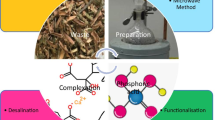Abstract
In the present study six adsorbents viz. wood charcoal, fly ash, coconut charcoal, saw dust, coconut fiber and baggasse charcoal were studied for their capacity to remove atrazine from water. The removal efficiency of different adsorbents varied from 76.5% to 97.7% at 0.05 ppm concentration and 78.5% to 95.5% at 0.1 ppm concentration of atrazine solution, which was less than removal efficiency of activated charcoal reported as 98% for atrazine (Adams and Watson, J Environ Eng ASCE 39:327–330, 1996). Wood charcoal was a cheap (Rs 15 kg−1) and easily available material in house holds. Since wood charcoal was granular in nature, it could be used for the removal of atrazine from water to the extent of 95.5%–97.7%. Fly ash is a waste product of thermal plant containing 40%–50% silica, 20%–35% alumina, 12%–30% carbon and unburnt minerals having a high pH of 9–10. It is very cheap and abundant material and has comparatively good adsorption capacity. It was found that fly ash effectively removed about 84.1%–88.5% atrazine from water at 0.05 and 0.1 ppm levels. Coconut shell is also waste product. Therefore, both are inexpensive. The removal efficiency of atrazine from water was 92.4%–95.2% by coconut shell charcoal and 85.9%–86.3% by coconut fiber. Sawdust is generally used as domestic fuel and found everywhere. It is also very cheap (Re. 1 kg−1). Baggasse charcoal is a waste product of sugar mill and abundant material. Its cost is due to transport expense, which depends upon distance from the sugar mill. The removal efficiency of sawdust and baggasse charcoal was found 78.5–80.5 and 76.5–84.6, respectively. The efficacy of chemically treated adsorbents for the removal of atrazine from water is in the order: wood charcoal > coconut shell charcoal > fly ash > coconut fiber charcoal > baggasse charcoal > sawdust.

Similar content being viewed by others
References
Adams DC, Watson LT (1996) Treatibility of s-triazine herbicide metabolites using powder activated carbon. J Environ Eng ASCE 39:327–330
Carter DL, Heilman MD, Gonzalez CL (1965) Ethylene glycol mono ethyl ether for determining surface area of silicate minerals. Soil Sci 100:356–360
Chang S, Lee S, Je C (2005) Phytoremediation of atrazine by popular trees: toxicity, uptake and transformation. J Environ Sci Health B 40:801–811
Clausen L, Faricius I (2001) Atrazine, isoproturon, mecaprop, 2,4-D and betazone adsorption onto iron oxides. J Environ Qual 30:858–869
Graymore M, Stagnitti F, Allinson G (2001) Impact of atrazine in aquatic ecosystems. Environ Int 26:483–495
Ghosh PK, Philip L (2006) Environmental significance of atrazine in aqueous systems and its removal by biological processes: an over view. Glob Nest J 8(2):159–178
Ghosh PK, Philip L (2005) Performance evaluation of waste activated carbon on atrazine removal from contaminated water. J Environ Sci Health B 40(3):425–441
Hayes TB, Collins A, Lee M, Mendoza M, Noriega N, Stuart AA, Vonk A (2002) Hermaphroditic, demasculinized frogs after exposure to the herbicide atrazine at low ecologically relevant doses. Proc Natl Acad Sci USA 99:5476–5480
Jiang H, Adams C, Graziano N, Roberson A, Mac Guire M, Khiari D (2006) Occurrence and removal of chloro-s-triazine in water treatment plants. Environ Sci Technol 40:3609–3616
Keerthinarayana S (1994) Sorption of lindane from water environment by wood charcoal, Ph.D. Thesis, Civil Engineering Department, IIT, Kharagpur, India
Moorman TB, Jayachandran K, Reungsang A (2001) Adsorption and desorption of atrazine in soils and subsurface sediments. Soil Sci 166:921–929
Sharma RK, Maurya AK, Kumar A, Joseph PE (2006) Screening of low cost adsorbents for removal of atrazine from water. Pestic Res J 18(2):205–207
Sudhakar Y (1999) Abatement of endosulfan from water environment by indigenous wood charcoal, Ph.D. Thesis, IIT, Kharagpur, India
Welcher FJ (1963) Standard methods of chemical analysis, Part B, 6th edn. Van Nostrand Reinhold, New York
Welhouse GJ, Bleam WF (1992) NMR spectroscopic investigation of hydrogen bonding in atrazine. Environ Sci Technol 26:959–964
Wicklund K, Dich J (1994) Cancer risks among female farmers in Sweden. Cancer Causes and Control 5:449–457
Zhu D, Kwon S, Pignatello J (2005) Adsorption of single ring organic compounds to wood charcoals prepared under different thermo chemical conditions. Environ Sci Technol 39:3990–3998
Acknowledgments
Authors are thankful to the Principal and Head, Department of Chemistry, St. John’s College, Agra (UP), India, for providing research facilities. Our thanks are also due to Dr. V. T. Gajbhiye, Principal Scientist, IARI, New Delhi for continuous guidance during research work.
Author information
Authors and Affiliations
Corresponding author
Rights and permissions
About this article
Cite this article
Sharma, R.K., Kumar, A. & Joseph, P.E. Removal of Atrazine from Water by Low Cost Adsorbents Derived from Agricultural and Industrial Wastes. Bull Environ Contam Toxicol 80, 461–464 (2008). https://doi.org/10.1007/s00128-008-9389-6
Received:
Accepted:
Published:
Issue Date:
DOI: https://doi.org/10.1007/s00128-008-9389-6




